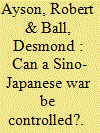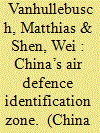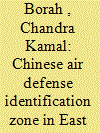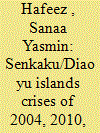| Srl | Item |
| 1 |
ID:
138613


|
|
|
|
|
| Summary/Abstract |
It has been decades since the last war between major powers in Asia, but there is no guarantee that the region will always be able to avoid conflict. The greatest strain on the peace is in North Asia, where there has been rising tension between China and Japan. What begins as a
minor skirmish between China and Japan could conceivably escalate into a more serious conflict that involved the United States and, in the worst case, the use of nuclear weapons by Beijing and Washington. Even a major conventional conflict (between just Japan and China, or
involving all three) could be devastating for North Asia and the wider region, leading to a significant loss of life and widespread political, institutional and economic damage.
|
|
|
|
|
|
|
|
|
|
|
|
|
|
|
|
| 2 |
ID:
144094


|
|
|
|
|
| Summary/Abstract |
China’s establishment of its Air Defence Identification Zone (ADIZ) is yet another manifestation on the strenuous development of regional security in East Asia. China by virtue of its so-called lawfare has instrumentalized international air law, the law of the sea, and law on the use force to reinforce its comprehensive security doctrine both on the military as well as economic front. Accordingly, China has advanced is sovereign interests through each of these branches of international law when extending its domestic laws in airspace above its Exclusive Economic Zone (EEZ), affirming its sovereignty over the disputed islands and being prepared to respond to imminent threats. Conversely, opponents of the zone have equally exploited those normative frameworks to defend their geopolitical and strategic interests in East Asia under the veil of the communitarian freedoms of overflight.
|
|
|
|
|
|
|
|
|
|
|
|
|
|
|
|
| 3 |
ID:
139368


|
|
|
|
|
| Summary/Abstract |
The unilateral declaration of Air Defense Identification Zone (ADIZ) by the Chinese government and its enforcement from 23 November, 2013, 10 AM (Chinese time) has triggered a different kind of geopolitical scenario and geo-strategic consideration in Asia. The changing nature of geopolitics can be seen in terms of the reactions that the states have shown. This is perceived differently by other states, especially the rival forces as the symbolism of Chinese expansionism.
|
|
|
|
|
|
|
|
|
|
|
|
|
|
|
|
| 4 |
ID:
138750


|
|
|
|
|
| Summary/Abstract |
The diplomatic situation between Japan and China over the Senkaku/Diaoyu Islands has become increasingly precarious over the past decade. Weak diplomatic ties and lack of trust between the two nations has made a clash not only more likely, but also unlikely to be effectively contained. This article compares the events and management of three diplomatic crises concerning the islands, including the deportation of Chinese activists who landed on the islands in 2004, the detention of a Chinese fishing boat captain who collided with a Japan Coast Guard vessel in 2010, and the 2012 nationalization of three of the islands by the Japanese central government. These case studies reveal the lack of reliable high-level communication mechanisms between Tokyo and Beijing, diminishing back-channel diplomacy and the asymmetrical influence of each respective Foreign Ministry as just a few of the structural barriers to effective Sino-Japanese crisis management.
|
|
|
|
|
|
|
|
|
|
|
|
|
|
|
|